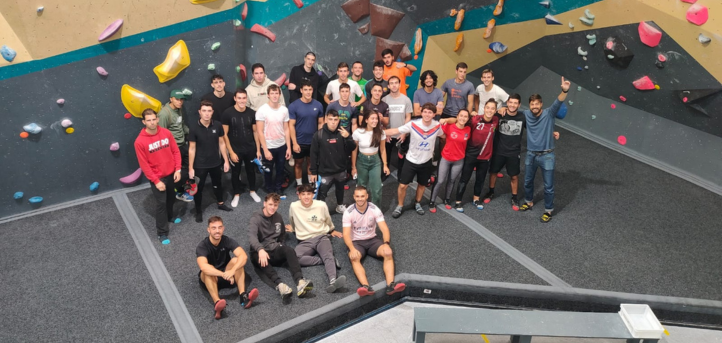About 100 fourth-year students of the Sport and Exercise Science (CAFYD) program of the Universidad Europea del Atlántico (European University of the Atlantic) immersed themselves last week in the exciting experience of climbing in the Indian Rock climbing wall, located in Santander, as part of their participation in the subject Physical Activity in the Natural Environment. In this activity, about a hundred students were divided into four groups, accompanied by UNEATLANTICO professors Juan Aparicio and Florent Osmani.
The objective of the session was to complement, through personal experience, the knowledge acquired by the student in the vertical, terrestrial environment content block. In this sense, the subject Physical Activity in the Natural Environment includes conceptualizations such as the different modalities of vertical AFMN, types of climbing, specific materials for vertical progression, safety protocols in the discipline and accident prevention, rope work applied to the discipline, and the introduction to rappel and climbing itself in the school context.
The students practiced a series of bouldering climbing techniques and the safest climbing modality, top rope, in which the rope that secures the climber goes on top in order to progress in total safety. The didactic objectives pursued by the teachers who led the sessions were to know the technical elements and materials necessary for the practice of climbing and to understand the different climbing techniques through practice in a real environment. Likewise, we seek to raise awareness of the risk inherent in any practice performed in a vertical environment, where the possibilities of accidents increase, so it is necessary to keep in a process of continuous training to acquire knowledge that minimizes the risks of the discipline. It is also intended that students can experience the sensations associated with overcoming motor and cognitive difficulties on a climbing wall.
The purpose of these learning sessions is not to instruct or train the student in the practice of such activities —since specific formal training exists for that purpose— but to warn them of the dramatic consequences of an irresponsible use of these techniques. The impressions of the teachers as coordinators of the practice “have been positive since the activity has been developed under strict safety protocols that have allowed the students to enjoy the days and share the benefits of this sport. We have managed to transmit to the students some of the physical and psychological benefits of this sport.”
Regarding the benefits of the activity, the teachers who have promoted it emphasize “it clears the mind and focuses us on the present, improves strength and static / dynamic balance, also provides improvements in joint mobility and flexibility, strengthens muscles, tendons, and ligaments, reinforces concentration, companionship, and confidence. There is no doubt that it generates self-improvement, socialization, improves mood, and reduces anxiety and stress. And finally, it increases agility of thought and fear control.”
To conclude, teachers Aparicio and Osmani say they are “pleased that some students who had not experienced climbing want to continue to approach it and integrate it into their lives as a constructive and healthy habit. We would also like to thank the Indian Rock team for their good work and treatment.


